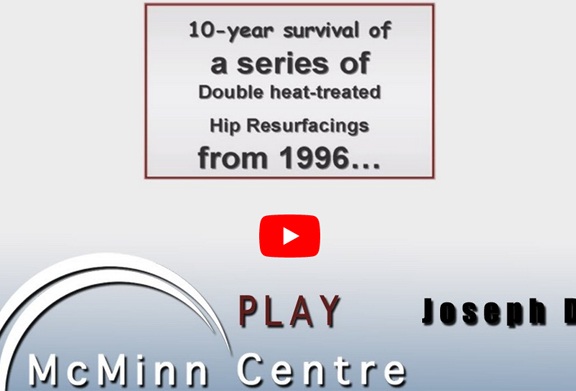|
10 year survival of a series of Double Heat-Treated Hip Resurfacings from 1996 Presented by Mr Joseph Daniel FRCS

In this lecture, Director of Research Joseph Daniel examines the ten year survival results of a double heat-treated hip resurfacing series from 1996. Mr Daniel discusses the metallurgy of bearings and how post-cast heating can have a detrimental effect, leading to increased wear, osteolysis and cup loosening.
Mr Joseph Daniel, Mr McMinn's staff surgeon and Director of Research at The McMinn Centre, gives and overview of the ten years results of a double heat-treated series of resurfacings from 1996 performed by Professor Derek McMinn. The implant used in this series was one of the earlier resurfacing designs that preceded the Birmingham Hip Resurfacing (BHR) – the first widely successful hip resurfacing implant. Another series, using successful large headed metal-on-metal bearings made from as-cast cobalt chrome showed little or no effects of wear.
Mr McMinn believed that this series of as-cast bearings could hold the key to success with hip resurfacings, as long as the metallurgy was the same. Between 1991 and 1995, as-cast bearings were used. In '96, the manufacturer started double heat treating bearings – a cost cutting exercise unknown to the implant designer Derek McMinn. Post-casting, heat-treatment results in dissipation of carbon into the metal matrix leading to reduced hardness in the alloy. Increased wear can then lead to osteolysis and loosening of the components over time.
The development of Osteolysis in patients over time is studied through a series of x-rays, taken at the pre-op, two month and ten year stages. Metal debris from increased wear can lead to the need for revision surgery. Footage from a revision surgery shows the extent of metal debris produced by a double heat treated bearing. Mr McMinn has highlighted the problems with double heat treating in various publications.
For more information on metal ions and the Birmingham Hip Resurfacing (BHR), please read the Metal Ions Questions and Answers section of our website: http://www.mcminncentre.co.uk/metal-ions-questions-answers.html
|